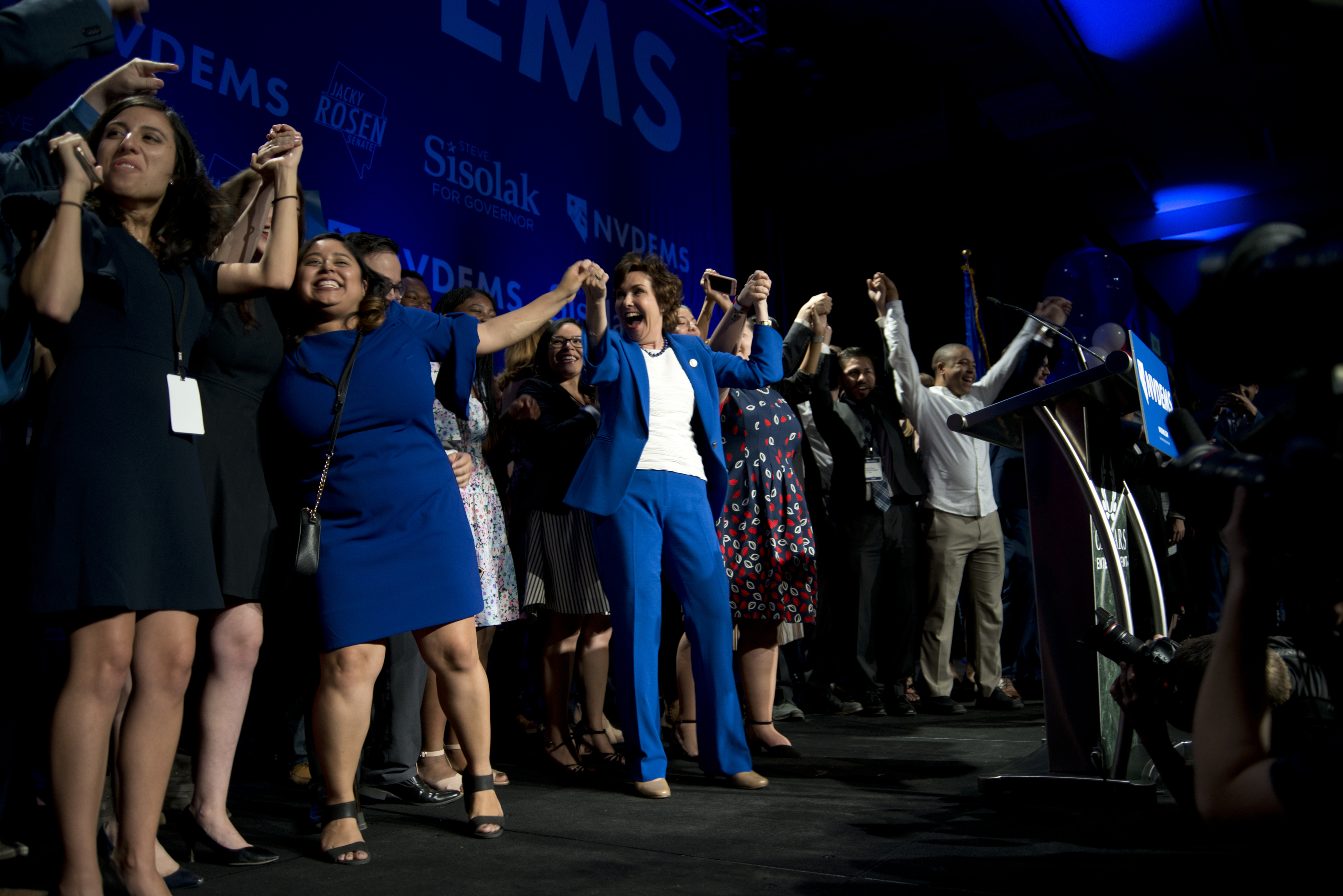Anatomy of a blue wave: Why Nevada Democrats won decisively in races that were supposed to be close

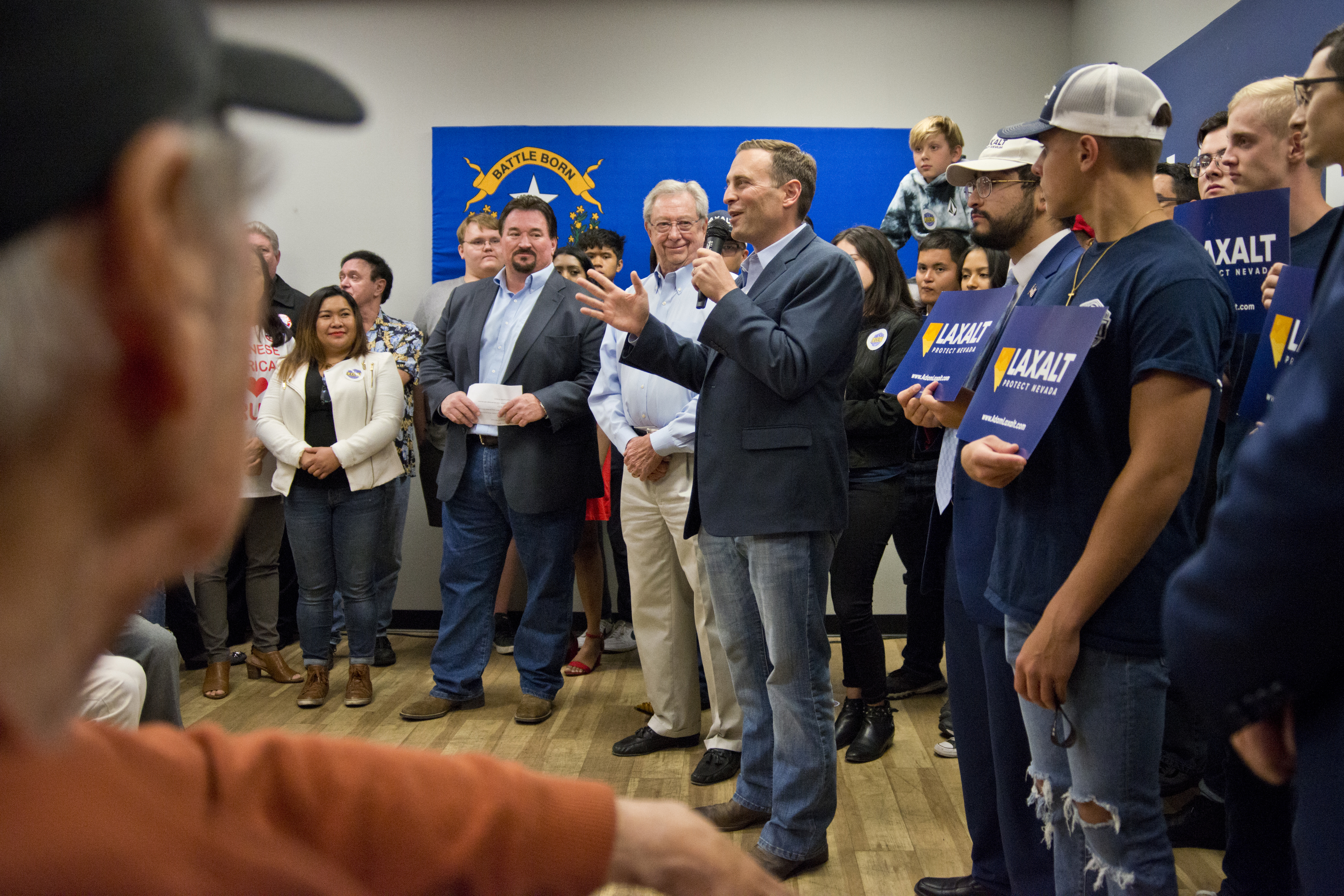
The night before the election, Republicans crowded into a Las Vegas campaign office with TV cameras rolling and told their volunteers that they were feeling great about their chances.
Attorney General Adam Laxalt said he firmly believed there were enough Nevadans to put him in the governor’s office and help him “save” Nevada. State Sen. Michael Roberson confided to the audience that they were going to win. And state party chair Michael McDonald proclaimed that “this is the greatest team we’ve ever assembled in the history of the state.”
“Take tomorrow off,” McDonald said. “Because tomorrow night, you’re going to celebrate when we turn this entire state red!”
But as Election Night rolled on, it became increasingly clear that there would be no celebration on the Republican side. In spite of Laxalt’s suggestion on the eve of the election that the governor’s race might come down to 500 votes, races like his that polls indicated were pure toss-ups were won by Democrats by margins of tens of thousands of votes.
In the aftermath, Republicans who had trusted deeply in their enhanced ground game and laser-focused approach to voter targeting grappled for answers. An incredulous McDonald told conservative radio host Kevin Wall that he didn’t trust the integrity of the election.
“I just don’t believe what happened. I really don’t. I want to see proof. I think there’s some shenanigans,” he said, without offering evidence of that conclusion. “I think there’s fingers on the scale more than anything.”
(Nevada Secretary of State Barbara Cegavske’s office has since said they received no credible reports of voter fraud stemming from the election.)
Others have sounded tones of resignation — that two consecutive elections have established that Nevada is a blue state, that the conventional wisdom of a low-turnout midterm no longer applies, and that Republicans can’t compete in years where Democrats are motivated to vote.
“I don’t believe there's one thing we could have done differently that would have improved our chances of success,” Republican Danny Tarkanian wrote in a Facebook post after losing a House race against Democrat Susie Lee by a wider margin that he lost the same district in the 2016 presidential cycle. “Nevada has become a blue state. When the Democrats are motivated to vote it will be tough for any Republican to win.”
Others still have posited that the messaging simply worked against Republicans this year — the economy wasn’t as salient an issue in Nevada because the economy here was already good before the tax reform bill passed last December and Democrats and independents were energized on health care.
To hear Democrats tell it, the victories in competitive Senate and governor’s races, all but one statewide race, two competitive House races and a large number of competitive legislative contests are a product of reaching out to voters on the ground early and often, of a political infrastructure years in the making, and of courting infrequent, younger and minority voters. They also believe Republicans misstepped by hewing too closely to a polarizing president, focusing on a base that’s euphoric about the president’s leadership at the expense of the moderates they needed to cross the finish line.
“Certainly Trump has a lot of supporters here, and strong supporters,” said Michelle White, state director of the progressive organization For Our Future. “But I think they overestimated how big that percentage was and they underestimated how much that was turning off folks in the middle.”
To hear it from billionaire progressive activist Tom Steyer, whose wealth funds For Our Future and other groups active in Nevada, the results were an extension of sentiment expressed across the country by Democrats who picked up at least 32 more House seats and seized the chamber from Republicans.
“This was a referendum on our president and this administration,” he said in a post-election debrief call with reporters last week. “The biggest takeaway is the president was on the ballot … and he got creamed.”

The Republican ground game
Republicans were enthusiastic headed into this election cycle.
They understood they had been out-organized by Democrats — and undermined by their own internal divisions — in the past and were determined to not let that happen again. They even took a page out of the Democratic playbook and set out to gather as much data on voters as possible while building out a robust volunteer infrastructure.
The Republican National Committee landed on the ground in Nevada in June 2017 and, a year later, had trained 1,300 fellows and volunteers under its neighborhood team organizing model. The goal was to build as many neighborhood teams across the state as possible consisting of a leader, who was responsible for building relationships within the community; core team members, who specialized in certain areas such as data or faith-based initiatives; and volunteers.
The RNC also doubled down on its predictive analytics system — called the National Voter Scores program — that crunches the numbers on how likely voters are to turn out to the polls or vote Republican based on billions of data points collected on Nevada voters. Those data points included everything from purchased consumer data to information obtained at the door or over the phone from the voters.
The overarching goal of the volunteer and data programs was party cohesion. While individual campaigns focused on winning primaries, the RNC was hard at work building its volunteer army to activate ahead of the general election, and those volunteers would know who to focus on urging to the polls because of the data the party had gathered on them.
By August, Republicans had made one million voter contacts — a number that included both attempted and successful contacts made with voters via door knocking or phone call — in Nevada surpassing the number of contacts they made in the entire 2016 cycle. They touted their work as “unprecedented.”
And it was. But it also wasn’t enough.
Rick Gorka, deputy communications director for the RNC, believes that the work that Republicans did on the ground in Nevada staved off an even worse defeat.
"Based on the margin of defeat, I have no doubt that what the RNC was able to do with the Nevada GOP and with the campaigns made it as close as it was,” Gorka said. “... We kept it a lot closer than it could have been."
In spite of the loss, he said the RNC put a “historic level” of investment into training volunteers in Nevada this cycle and that those volunteers now have the know-how to organize within their communities, no matter how big or small the race.
“They’re trained to recruit volunteers and get organized in their communities. It could be around a ballot initiative, a school board race, or around the president’s race in 2020,” Gorka said. “Those individuals are still there with the skills to carry on and get ready for the next battle. We did a historic level of trainings in Nevada and there’s undoubtedly success in that to have a lasting impression in the state even though we fell short on Tuesday.”
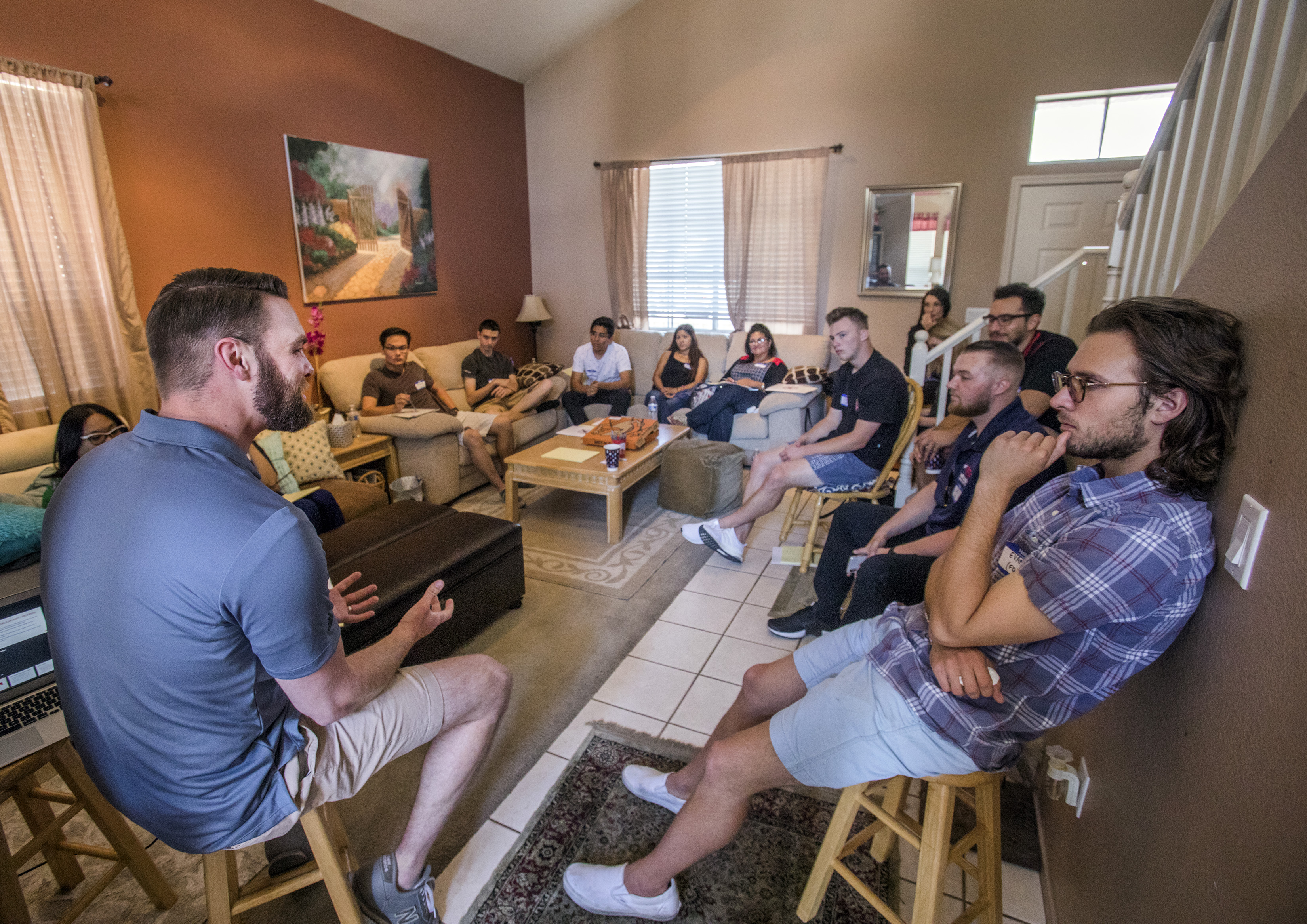
But there’s also been much post-election soul-searching among Republicans about the impact that the national political climate had on Nevada. Pete Ernaut, a longtime Republican strategist, chalked Republican losses up to Trump.
"I think there’s really only one way to analyze this election, and it was a referendum on the president,” Ernaut said. “There’s no other explanation for the consistency of who won the races and by what margin."
Ernaut said that rural counties turned out in droves to support the president, while voters in suburban and metropolitan areas turned out in significant numbers to oppose him and, by extension, Republican candidates. Frustration with incumbents leads to a midterm election pattern in which the party in power typically loses ground.
But he also attributed part of Republicans’ losses to the focus throughout the election on health care and not the economy.
"Independent voters tend to be very focused on the issues, hence the reason they’re independent,” Ernaut said. “They tend to be very discerning about the narrative of the election. Again, if the narrative of the election would have been on the economy, those voters would tend to lean Republican."
A focus on preventing Nevada from becoming California also didn’t seem to do the trick, according to UNLV political science professor David Damore, who said that message didn’t address anyone’s real needs.
“The Democrats had a pretty disciplined message and the Republicans didn’t have much,” he said. “Just hoping that voters in Clark County stayed home like in 2014 just seemed like a real mistake.”
Other Republicans acknowledge that tax reform may not have been as successful an issue for members of their party to campaign on in Nevada simply because the voters here already felt like the economy was doing well — with booming construction and a host of new tech companies relocating to the state in recent years — before Congress passed its tax reform legislation last December.
But with those new jobs — and an influx of even more Californians to the state — there is a concern among some, though not all, Republicans that the state may be indelibly shifting toward the left.
Voters in the Silver State have swung for the Democratic presidential candidate in the last three elections — President Barack Obama in 2008 and 2012 and former Secretary of State Hillary Clinton in 2016. They’ve also elected a Democratic Senate candidate in three of the last four elections — former Sen. Harry Reid in 2010, Sen. Catherine Cortez Masto in 2016 and now Sen.-elect Jacky Rosen in 2018.
That’s not to say Republicans haven’t had any victories over the last decade — notably, the red wave of 2014 in which Republicans swept all six constitutional offices and took control of both chambers of the Legislature and Republican Dean Heller’s win in the U.S. Senate race in 2012 — but some Republicans are increasingly viewing those wins as exceptions to the rule.
Lt. Gov. Mark Hutchison, who chaired Heller’s unsuccessful 2018 re-election campaign, said Republicans need to be “clear-eyed” that Nevada is more a blue state than a purple state, and adjust their approach accordingly. He called for attracting more conservative and blue-collar Democrats, and more of an outreach to minority communities.
“We had a big turnout of our voters and I love our Republican turnout. We had a … bigger turnout for the Democrats. So we’ve got to say, how do we increase the size of the tent?” he said in an interview last week on the Kevin Wall radio show. “I still believe the fundamental principles, the fundamental reasons that we’re Republican — limited government, limited regulation, low taxes, individual freedoms — resonates with people far beyond our party.”
Others, including conservative political consultant Chuck Muth, chalk the losses up to candidates who were too bland to inspire their conservative base and flip-flopped or flocked to the middle.
“A political campaign is about marketing. Donald Trump gets it. Ronald Reagan got it,” he said in an interview with Wall, adding that Republicans also needed to do a better job of clearing the field of conservative “spoiler” candidates such as nonpartisan gubernatorial candidate Ryan Bundy.
Regardless of the reason, the losses up and down the ticket are a tough swallow for Republican Assembly Leader Jim Wheeler, whose party will be in a super-minority next session. Assembly Democrats will be able to pass any bills — including tax increases that require two-thirds support — without a single Republican vote.
Wheeler said he thinks too much attention and resources went to top-of-ticket races, and might be better spent winning over voters in smaller, more personal legislative races in a ground-up approach. Campaign donors, who predicted Democratic dominance, focused their money on Democratic legislative candidates and made it difficult for Republicans to get their message out, he said.
“I think we need to show the people in the middle that the conservative message is the correct one,” he said. “In the urban areas, we’ve been portrayed as the enemy for so long. It’s going to be hard to overcome that.”
He also thinks press coverage did not help. (Several top Republican candidates refused to talk with The Nevada Independent throughout the campaign cycle.)
“While I’m not going to blame the press,” Wheeler said, “the press is not friendly to us.”
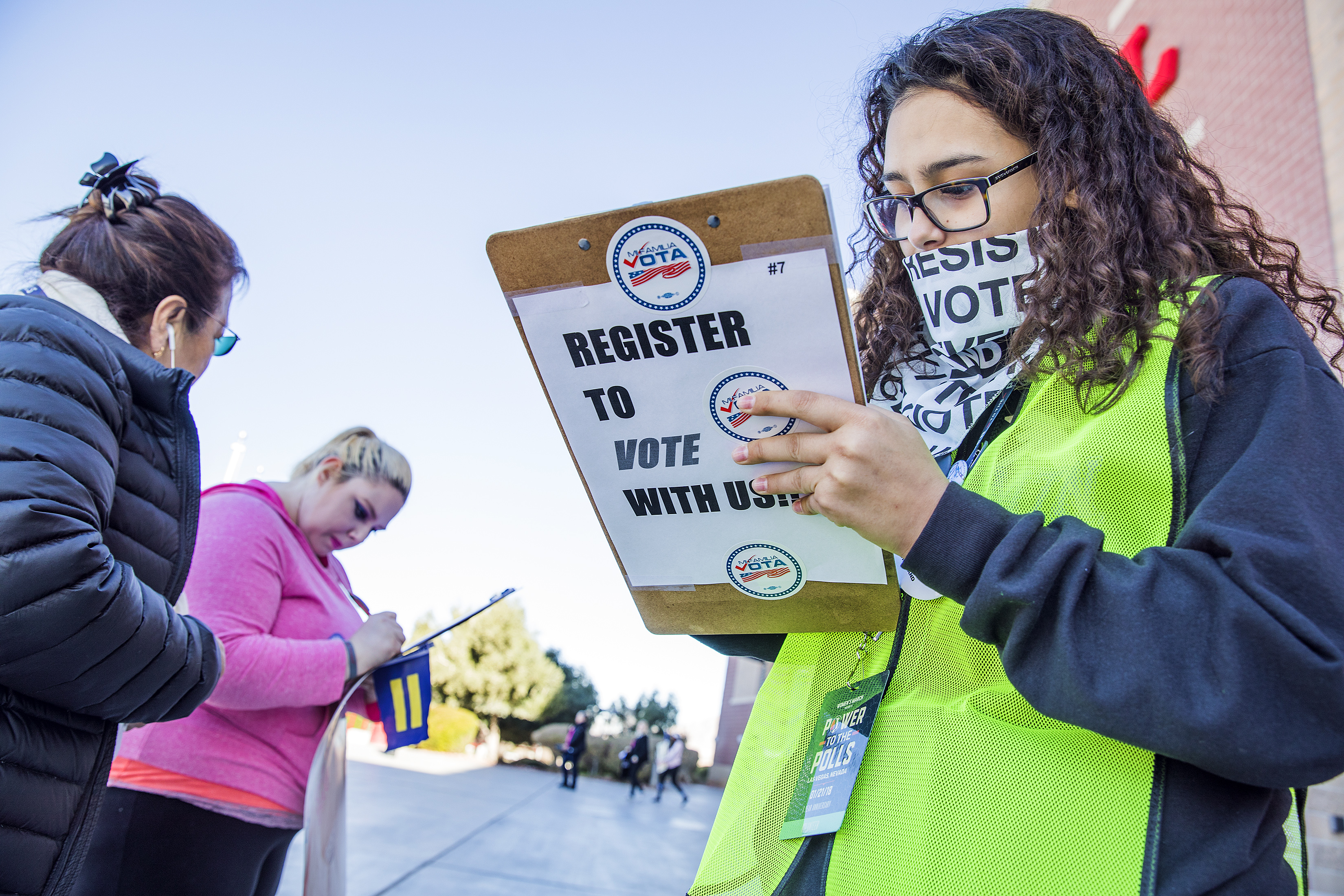
The Reid machine
While Republicans focused on diligently growing their political machine this cycle — and were vocal about their efforts to do so — Democrats quietly dusted theirs off, added a little oil and turned it on.
The state had gone blue in 2016 with Clinton’s and Cortez Masto’s victories and Democrats flipping control of two House seats and both chambers of the Legislature. They needed to do it again, but this time with a reminder in their rearview mirror that they don’t always get what they want.
“Because in 2016, we did everything right in Nevada and we still got Donald Trump as a president, I think we knew what was at stake,” said Annette Magnus, the executive director of the progressive group Battle Born Progress. “We didn’t let off the gas. In fact, we just kept pushing harder and harder and harder as we got closer to Election Day and that is what really made the difference.”
If the strategy seems simple, it’s because it is: Register as many voters as you possibly can, recruit and train volunteers, and use those volunteers to get those voters to turn out to the polls through door-knocking and phone-banking. It’s what the Republicans tried to replicate but what helped Democrats ultimately prevail.
Over the cycle, Democrats knocked on 1.3 million doors, made 2.6 million calls, and sent 1.2 million text messages to voters, with most of that in the final three weeks of the campaign, according to the state Democratic Party.
“It’s simple. It’s not glamorous, but we know that’s what we need to do,” said Alana Mounce, executive director of the Nevada State Democratic Party.
Democrats attribute their victory in part to treating the election more like a presidential year and less like a midterm, with Mounce noting that the party is aided by a year-round infrastructure that allows it to “turn on a dime” instead of ramping up cycle after cycle. Democrats had about 7,000 active volunteers that completed nearly 40,000 volunteer shifts over the course of the cycle, roughly comparable to the 7,300 active volunteers who completed nearly 35,000 shifts over the 2016 cycle.
“The organization felt like and looked like a presidential level organization to me,” Mounce said. “... I think the RNC invested in the state and talked a lot about the organization they were building, the doors they were knocking, the voters they were registering … but we still have a better turnout program than they do because of the state party and the year round infrastructure we’ve invested in the long-term growth of our Democratic voter registration advantage.”
Democrats managed to widen their voter registration advantage from its low point — 59,084 or a 4.2 percentage point advantage in March — to 74,923 or 4.8 points at the close of registration in October. (Democrats were still at a disadvantage compared to their voter registration advantage during the red wave of 2014, 5.1 points, or the blue wave of 2016, 6.1 points.)
“Being able to expand the electorate is part of how we win here,” Mounce said.
This operation that Democrats have built cycle over cycle — nicknamed the Reid machine for the eponymous de facto head of the Nevada State Democratic Party and built by longtime operative Rebecca Lambe — is less one discrete entity and more the assemblage of the party, labor organizations and third-party groups committed to electing Democratic candidates.
While they are not allowed to directly coordinate with the campaigns, some 30 “independent expenditure” unions, organizations and PACs aligned with Democrats banded together under an umbrella entity called “America Votes,” which helped conduct the orchestra of different groups and ensure they were not duplicating efforts.
“We really do work together well, and we’re consistently talking to each other,” said Lindsey Harmon, executive director of Nevada Advocates for Planned Parenthood, one of the America Votes partners. “And we have some great leaders and minds in this state that are of the Reid school of thought which is let’s get together and let’s win this as a group and let’s turn out the people that are underrepresented.”
The Reid machine is also a function of mentorship: Magnus credits Lambe and Democratic operative Megan Jones with helping cultivate a new generation of progressive leaders, many of them women, who carry on their advocacy even in the off-season.
“It’s not just this thing that comes in every cycle, does all this work and then leave. We all live here. We all work here. Our issues are important. We are doing this work all the time,” Magnus said. “I don’t necessarily see it as a machine as much as a movement that they have really worked to build.”
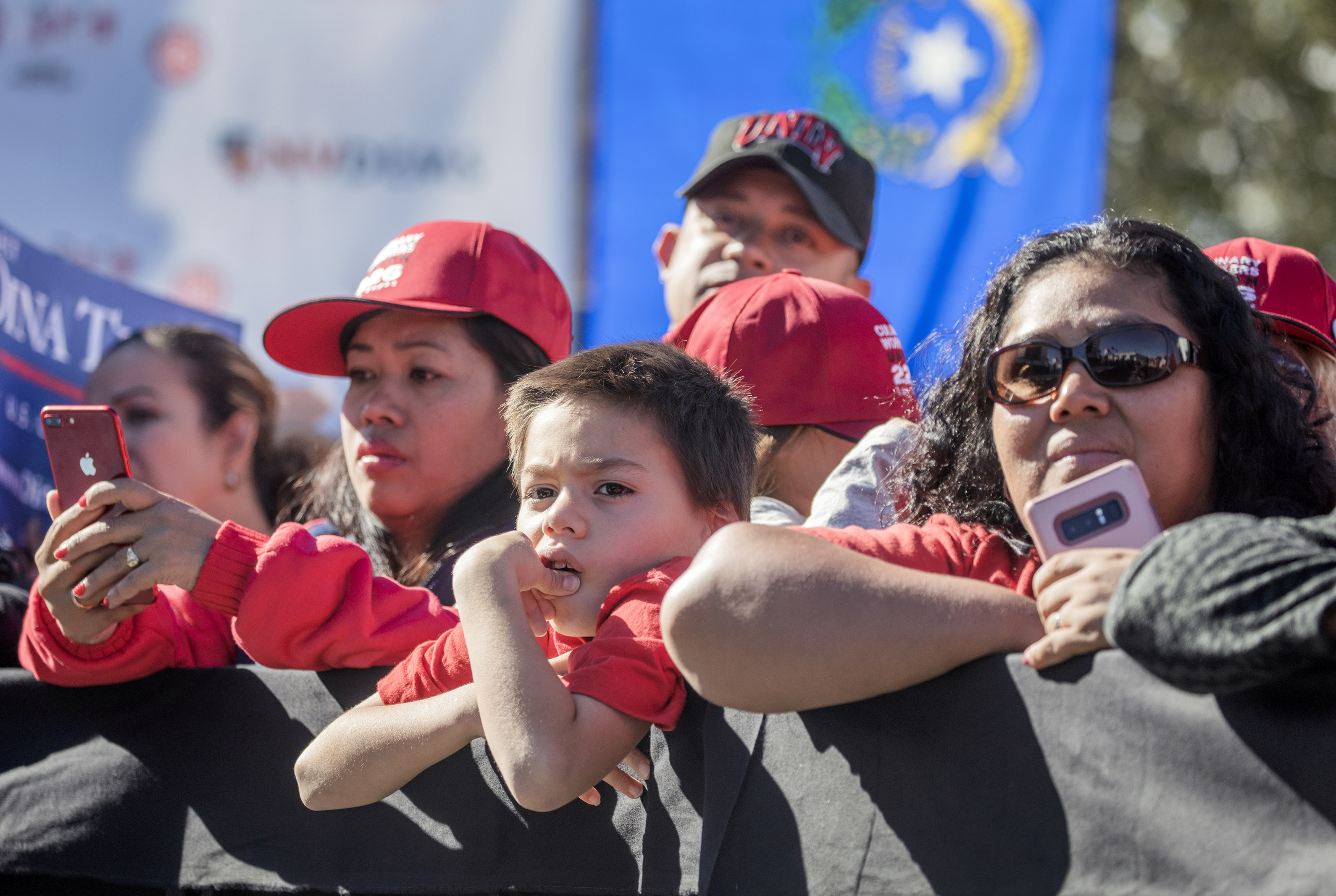
The politically powerful Culinary Union, which represents 57,000 guest room attendants, servers, bellmen and others at resorts in Las Vegas in Reno, again played a key role in the Democratic turnout operation this year, with 350 workers taking a leave of absence to urge voters to turn out to the polls. In total, the union knocked 370,000 doors, had 80,000 one-on-one conversations with voters, made 45,000 personal calls, sent 1.8 million pieces of mail, sent regular emails and texts to members and ran video ads with 3.5 million views.
It was even more effort than the union put in two years ago, when 300 workers took a leave of absence to knock 350,000 doors and talked to 75,000 voters, or in 2012, when 110 workers took a leave of absence to register and turn out members and their families to vote. (Focused on a major contract fight, the union did not run a political program in 2014.)
“I’m inspired by the women of color and young voters who were engaged and completely rejected Trump, his anti-worker/anti-immigrant agenda, and candidates in Nevada who were not fighting for our families and our communities,” said union spokeswoman Bethany Khan in an email. “We deserved better representation and elected officials, so we fought and won exactly that.”
Steyer-backed NextGen America focused on a demographic that is the least likely to vote — young people. State Director Tyson Megown said the group’s months of outreach in high schools and on college campuses included removing barriers to voting — starting with educating them on when, where and how to vote, and providing rides from campus to voting centers.
“Sometimes a lot of young folks don’t vote because they simply don’t understand the process and they feel too embarrassed to ask,” Megown said.
The group also found that young people often register nonpartisan, even if they tend to vote 2-1 in favor of Democrats. NextGen’s approach started with talking about issues rather than party identification, and then providing potential voters with information about the candidates’ stances on those issues.
“We operated on the assumption that if we have these kinds of conversations, that we can see this level of turnout. And they proved us right,” he said.
Backing up those efforts were groups including the Democratic Congressional Campaign Committee, which launched an aggressive outreach program to Latino and other minority voters. That included the committee’s first-ever multi-state Spanish-language TV ad that aired in Las Vegas as competitive races played out in Nevada’s 3rd and 4th congressional districts, zeroing in on a single Latino family to highlight the need to change the balance of power in Congress.
“We wanted voting to feel good rather than simply what is at stake and kids in cages and Trump,” DCCC Executive Director Dan Sena said in a conference call with reporters on Tuesday. “So we spent a fair amount of time studying how to create urgency without it feeling overly heavy or overly sad.”
The energy showed in a poll of battleground districts taken by Latino Decisions in the days just before the election. It found that Latino engagement was at an all-time high, with 77 percent of Latinos reporting they had been talking with their family about voting and 53 percent of respondents saying they had been contacted by a campaign.
“I think the Democrats and organizations like [For Our Future] and on the other side made a really concerted effort to reach out to voters in communities that are oftentimes overlooked, particularly communities of color so they might not have been found in the targets because maybe they haven’t voted in the last three elections, maybe they just got registered,” White said. “A lot of these communities, rightfully so, felt overlooked. They felt discouraged that their voice wasn’t being heard in this process.”
And as for whether the Reid machine lives on two years after Reid himself has left office? White thinks so.
“We saw it as our responsibility to carry this on. This isn’t about one man or one operative or one staffer or one candidate. This is a movement and a movement is never about one person or one election cycle,” White said. “When I look at this cycle, the first cycle without Sen. Reid in office, I think we made him really proud.”
